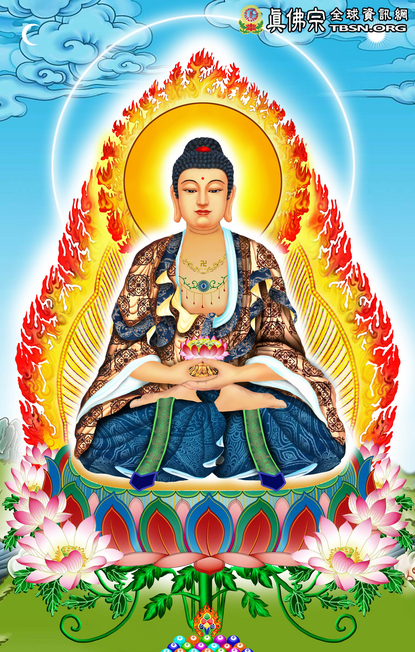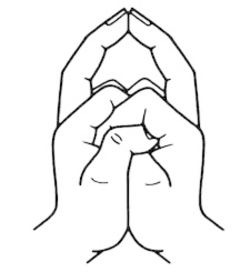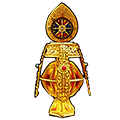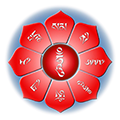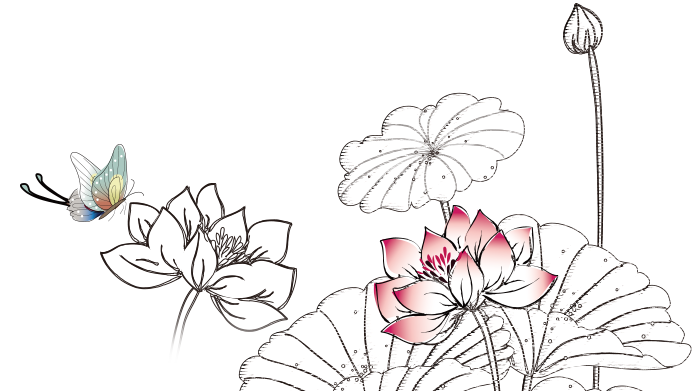On Sunday, Jan. 4, 2026, 2:00 PM, at Rainbow Temple, True Buddha School Dharma King Living Buddha Liansheng Sheng-yen Lu will preside over an Amitabha Ceremony, discourse on the Surangama Sutra, and bestow empowerment for Amitabha Buddha Principal Deity Practice. (Live Webcast Link: https://www.youtube.com/channel/UCLl20r-KQlapX_5fT-N3cOw)
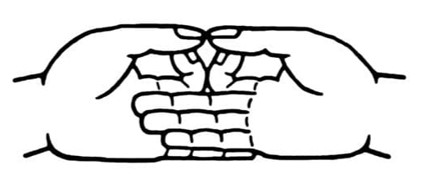

【Amitabha Seed Syllable :】

【Amitabha Mantra :】
「Om。ah- mee-deh-wah。seh。」
【Amitabha Dharmalakṣaṇa Brief Introduction】
 Red Amitabha wears a kasaya and sits atop a thousand-petaled lotus in full lotus posture. His hands form the Meditation Mudra while holding a nectar-filled bowl. He looks compassionately at all sentient beings.
Red Amitabha wears a kasaya and sits atop a thousand-petaled lotus in full lotus posture. His hands form the Meditation Mudra while holding a nectar-filled bowl. He looks compassionately at all sentient beings.【Living Buddha Lian-sheng Sheng-yen Lu Dharma Discourse - Amitabha Background and Key Cultivation Formula】
Amitabha is one of the three roots of Dharma King Living Buddha Lian-sheng Sheng-yen Lu. Amitabha made 48 great vows and has saved countless sentient beings. He is known as the ''Amitabha of every household.''
In Vajrayana, Amitabha is one of the five wisdoms of Vairocana Buddha. He was born in the Western Discriminatory Awareness Samadhi. In the Womb Realm, he is positioned west of the Central Eight Petal Hall. In the Diamond Realm, he is positioned west of the Five Liberations Wheel. He is the wisdom of expedient means of the Tathagata.
Amitabha has three names. In Sutrayana, he is called the Buddha of Infinite Life and the Buddha of Infinite Light. In Vajrayana, he is called Nectar King Tathagata. There are 13 other names of Amitabha as follows: Buddha of Infinite Life, Buddha of Infinite Light, Buddha of Boundless Light, Buddha of Unhindered Light, Buddha of Incomparable Light, Buddha of King Yama's Radiance, Buddha of Pure Light, Buddha of Joyful Light, Buddha of Wisdom Light, Buddha of Eternal Light, Buddha of Inconceivable Light, Buddha of Indescribable Light, and Buddha Transcending Sunlight and Moonlight.
Manjushri is the embodiment of Amitabha's wheel of true Dharma, whereas Yamantaka is the embodiment of Amitabha's wheel of injunction. Amitabha, Avalokitesvara, and Mahasthamaprapta comprise the trinity of Amitabha.
The Larger Amitabha Sutra discoursed by the Buddha has two versions. One version was rectified by Jinshi Wang Rixiu during the Song Dynasty. The other version is called the Sukhavati-vyuha. (This is also called the Larger Amitabha Sutra.)
In the sutra, the Buddha refers to an emanated youth, namely ''Padmakumara.''
The emanated lotus youths or Padmakumara are also referenced in our usual recitation of ''Namo the 36 trillion 119 thousand and 500 Amitabha Buddhas.'' Padmakumara is therefore Amitabha. The symbol of Amitabha is the lotus. The origin of Padmakumara is Amitabha. I took ''Lian-sheng'' as my epithet to reference ''lotus born,'' which is namely Amitabha Buddha.
Of all the buddhas, Amitabha has saved the most sentient beings in the Saha World. The Western Pure Land of Ultimate Bliss consists of three levels and nine classes. As long as one is single-minded and believes in Amitabha's vows, one is able to accomplish rebirth in the Western Pure Land of Ultimate Bliss. Even one who has broken precepts and committed the ten evil acts and the five heinous crimes can still be delivered to one of the nine lotus born classes in Amitabha's Pure Land and see the magnificent Western Pure Land of Ultimate Bliss if one recites the name of Amitabha Buddha single-mindedly at the time of passing. This is how transcendental the Western Pure Land of Ultimate Bliss is. Amitabha's vows are tremendous and magnificent. He is the Buddha of Immeasurable Life who has saved the most beings.
What is marvelous about Amitabha's Western Pure Land of Ultimate Bliss is that it consists of four pure lands - the Common Land of Ordinary and Holy Beings, the Land of Expedient Means for Beings with Remains, the Solemn Land of Permanent Rewards, and the Land of Eternally Quiescent Light. What is extraordinary about the Common Land of Ordinary and Holy Beings is that even those with karma can be reborn there, which is of great expediency. This incredible lotus environment can transform an ordinary being's mind of birth and death into the bodhi mind of no-birth and no-death.
Why is the Western Pure Land of Ultimate Bliss so well-known? Based on Venerable Yin Shun's research, Indians were more inclined to worship the setting sun. They somehow held sacred the feeling of the moment when the sun is about to set. They appreciated the mixed emotions felt by witnessing the sunset's glory and sadness. They always greatly worship the setting sun because it is about to end a day. In India, the meaning of buddhas being in the Western Pure Land of Ultimate Bliss mainly has to do with worshipping the setting sun, which always sets in the west. As a result, the Western Pure Land of Ultimate Bliss has become especially famous. ''Although the setting sun is splendid, it is close to dusk.'' The setting sun has magnificent brilliance, but is also kind of sadness, since it brings on the awareness that the day is about to end.
Once, someone asked Nora Rinpoche, ''What is Vajrayana's supreme Dharma?'' He replied, ''Vajrayana's supreme Dharma is the Great Dharma of Amitabha.''
Someone once asked me (Living Buddha Lian-sheng Sheng-yen Lu), ''In your life, you have practiced Taoism, Sutrayana, and Vajrayana. What is your goal?''
I answered, ''The Western Pure Land.''
''Why the Western Pure Land?''
''Among all the buddhas, Amitabha has the greatest vows of compassion, and the vows I've made are just the same as the buddha's vows to save sentient beings.''
The Great Amitabha Practice of merely chanting ''Amitabha'' is similar to the buddha-name chanting practice of the Pure Land Sect. It is a method of attaining Buddhahood by chanting a buddha name. Many practice this dharma, which is also the Easy Path of Practice. For most Buddhists, it is an easy practice to perform. To practice the Ten Recitations Method daily before leaving home, one inhales one time before starting to recite, then recites continuously until ready to exhale. One inhales a second time and repeats this cycle nine more times. One may leave home upon completion of the tenth cycle.
A step further is image visualization and buddha-name chanting. When in Seattle, Living Buddha Lian-sheng usually leads disciples in circumambulation of buddhas. While doing so, I visualize Amitabha as tall as a pine tree right in front of me. I continuously think of him as I am chanting. This is what the image visualization and buddha-name recitation is about; visualizing a buddha while simultaneously chanting the buddha's name.
If cultivating at a shrine, I visualize a small golden Amitabha emitting light. One of his hands forms the Wish-fulfilling Mudra while the other holds a lotus in the Lotus-holding Mudra. One may visualize the small Amitabha at one's forehead where the upper dantian is located. One may also visualize that Amitabha is as enormous as the void. That is, one visualizes the buddha's image while chanting the buddha's name.
Amitabha is truly magnificent. Among buddhas, Amitabha's name is chanted the most by sentient beings because of his supreme power to save sentient beings, his infinite light and life, and his deepest affinity with all sentient beings.
In the Nagarjuna Pure Land Text, Amitabha has a unique name, ''Namo the 36 trillion 119 thousand and 500 Amitabha Buddhas.'' Reciting the name one time is equivalent to calling all 36 trillion 119 thousand and 500 Namo Amitabha Buddhas!
Chanting buddha's name is an expedient means. When finished chanting Amitabha, one goes on to chant the name of Avalokiteshvara and Mahasthamaprapta. One chants ''Om, ma-ni pad-me hum'' for Avalokiteshvara and ''Om, xu-xu, suo, so-ha'' for Mahasthamaprapta. This is how I usually chant the buddha's names.
Amitabha Personal Deity Practice
!!Please be aware that before engaging in any True Buddha Vajrayana practices, one must first take refuge and receive the respective empowerment.!!
⓪Please check the True Buddha School website regularly for the latest news about Living Buddha Lian-sheng and "be with Buddha" always.
Official True Buddha School Net (TBSN):
Home page: http://tbsn.org/
Indonesia Home Page: http://tbsn.org/indonesia/
Official Facebook Pages:
Chinese: https://www.facebook.com/syltbsn
English: https://www.facebook.com/syltbsnenglish
Indonesia: https://www.facebook.com/syltbsnindonesia
⓪Welcome fans (Vajra Dharma Protectors) of the Official English True Buddha Facebook site to invite their friends to join the Fan Club. Better yet, click "Like" and "Share". Let us together spread the name of Dharma King Living Buddha Lian-sheng to every corner of the world!!

